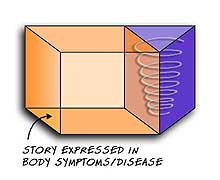PREVIOUS: The power of summary
One of the most important skills is education. The Illness Explorer Self-Help pathway, which is largely educational, provides many ideas for communicating the body and mind, illness and story connections.
One of the reasons I always introduce myself to a new patient as an immunologist, psychotherapist, and adjunct professor in MindBody Healthcare, is that I am from the beginning letting them know that, in my work with them, I will be talking to them, not just as a patient, not just with a focus on disease, but as a whole person. I go on to say that I take the view that mind and body are not divided, and that in my view many factors, both physical and non-physical, contribute to illness, and that I find the best results occur when we try to attend to both the physical and non-physical factors where they seem important. I am educating about the potential illness/story connections right from the beginning. Many people easily accept this. Others are more cautious.
 The prism metaphor (see Illness Explorer Self-Help pathway) can be very helpful to explain why we are getting symptoms in relation to our stories. All of us have feelings and emotions. Negative feelings are not always easy to express or manage. They may get represented in words, actions (excessive work, exercise, violence, drug-taking etc), or in bodily symptoms. The latter get presented to doctors who will treat them medically but usually will make very little connection with the underlying issues and feelings.
The prism metaphor (see Illness Explorer Self-Help pathway) can be very helpful to explain why we are getting symptoms in relation to our stories. All of us have feelings and emotions. Negative feelings are not always easy to express or manage. They may get represented in words, actions (excessive work, exercise, violence, drug-taking etc), or in bodily symptoms. The latter get presented to doctors who will treat them medically but usually will make very little connection with the underlying issues and feelings.
I am educating about the potential illness/story connections right from the beginning.
It may well be necessary to tackle the stigma associated with terms and ideas like ‘psychosomatic’, ‘all in my head?’, ‘not real?’, ‘are you saying I am making myself sick?’ From a whole person perspective, whatever the disorder, we are always dealing with a thoroughly human situation. A back pain due to a slipped disc is no more valid or legitimate or real than severe muscle spasm in the back due to a chronic state of stress, sadness and anger. Why do we not look from both mechanical and the emotional perspectives? Why do we privilege one over the other? Many patients benefit from these kinds of discussions.
Simply drawing attention to the illness and story connections may be enough for some patients to go away and to make changes in their lives, express feelings, sort out a relationship issue, or whatever is needed, and symptoms may settle. Of course this depends on the disorder. Some patients will welcome the fact that connections have been made but will need further support from the clinician, or more skilled help with a counsellor or therapist, especially one who has experience in the relations between story and disease.
I often regard myself as a kind of midwife. Something new is born in my consultations. Before the consultation many a patient is seeking, often desperately and unsuccessfully, a totally physical way of dealing with the illness. During the consultation there is born a new idea, that the illness may be a manifestation of a mix of physical and story factors. It is my job to gently and safely allow this process develop and emerge and blossom into something helpful and lively and healing. Educating the patient is part of this. Enabling them to get the help they need to explore and resolve the issues is another part of it.
Brian Broom
NEXT: Timing and waiting